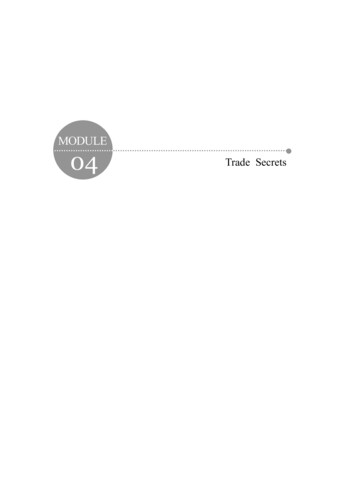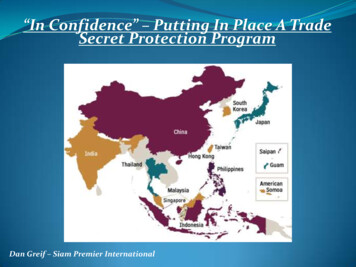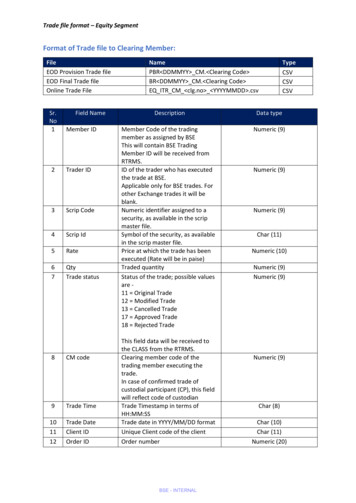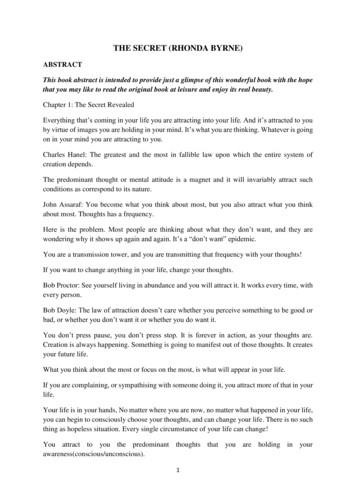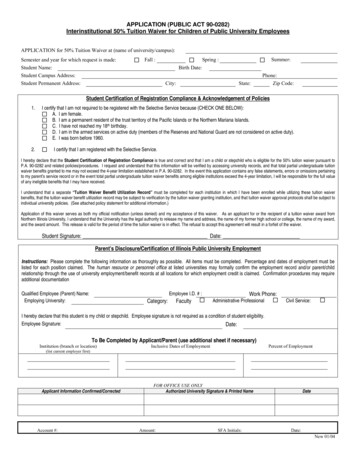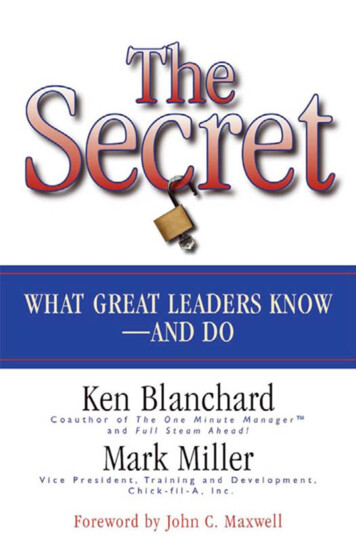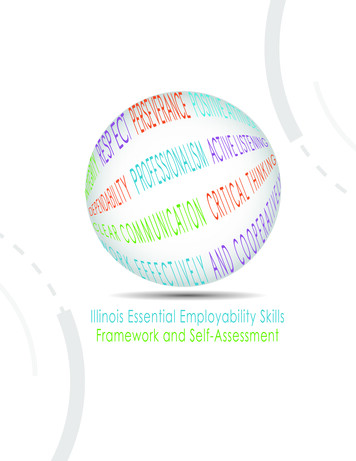
Transcription
ILLINOIS TRADE SECRET LAW:THEPECULIARPROBLEMPREEMPTIONOFWilliam Lynch Schaller * “The past is never dead. It’s not even past.”**I. INTRODUCTIONIn passing the Illinois Trade Secrets Act (ITSA) in 1987,1 the IllinoisGeneral Assembly largely codified existing Illinois trade secret law.2 Onefeature of the ITSA, however, had no pre-ITSA counterpart: the preemptionprovision found in Section 8. Section 8(a), the “positive” or pro-preemptionclause, purports to displace "conflicting tort, restitutionary, unfaircompetition, and other laws of this State providing civil remedies formisappropriation of a trade secret."3 In stark contrast stand the ITSA’s* **123Partner (Retired), Baker & McKenzie, Chicago, Illinois. I would like to thank my daughter,Alexandra J. Schaller of Loeb & Loeb, for her research and editorial assistance. All views hereinare mine alone and do not necessarily reflect the views of my daughter Ali, Loeb & Loeb, Baker &McKenzie or their respective clients; in fact, I am no longer a partner, employee or agent of Baker& McKenzie in any way. At my request, the editors have included parallel citations to the OfficialIllinois Reports as a courtesy to the Illinois Bench and Bar.This article is dedicated to my brother and best friend, Robert V. Schaller, a man of honor and anattorney without peer.2018 William Lynch Schaller. All rights reserved.WILLIAM FAULKNER, REQUIEM FOR A NUN 73 (Vintage Books ed. 2011) (1950).765 ILL. COMP. STAT. 1065/1-1065/9 (2016).Melvin F. Jager, Illinois Returns to the Mainstream of Trade Secret Protection, 2 CHI. B. ASSOC.REC. 18, 18-21 (1988) (discussing ITSA’s numerous departures from the Uniform Trade Secret Actin order to maintain, restore, and codify Illinois common law). The ITSA did work some changes,though, such as expressly overruling Disher v. Fulgoni, 124 Ill. App. 3d 257, 464 N.E.2d 639 (1stDist. 1984), and Cincinnati Tool Steel Co. v. Breed, 136 Ill. App. 3d 267, 482 N.E.2d 170 (2d Dist.1985). See Caroline Patricia Jamieson, Comment, Protecting Proprietary Information in Illinois:A Response to the Illinois Trade Secrets Act from a Drafting Perspective, 41 DEPAUL L. REV. 885,905 (1992) (briefly reviewing the legislative history of the ITSA and the preemption provisions inSections 8(a) and 8(b)(2), but mainly focusing on the extent to which Section 8(b)(1) overruledDisher v. Fulgoni and Cincinnati Tool Steel Co. v. Breed). It also impliedly overruled certain preITSA cases. See, e.g., Lucini Italia Co. v. Grappolini, No. 01-C-6405, 2003 U.S. Dist. LEXIS 7134,at *54 (N.D. Ill. April 28, 2003) (ITSA provides for injunctive relief and thus superseded the generalequity requirements of irreparable harm and inadequate remedy at law for injunctions); LearningCurve Toys, L.P. v. PlayWood Toys, Inc., No. 94-C-6884, 1999 U.S. Dist. LEXIS 11262, at *1719 (N.D. Ill. July 20, 1999) (ITSA impliedly overruled Illinois decisions, such as Schulenburg v.Signatrol, Inc., 50 Ill. App. 2d 402, 200 N.E.2d 615 (4th Dist. 1964), requiring "the defendantprofited" as a trade secret claim element).765 ILL. COMP. STAT. 1065/8(a) (2018).243
244Southern Illinois University Law Journal[Vol. 43“negative” or anti-preemption clauses. Section 8(b)(1) cautions that the ITSAdoes not affect "contractual remedies, whether or not based uponmisappropriation of a trade secret,"4 and Section 8(b)(2) further cautions thatthe ITSA does not affect "other civil remedies that are not based uponmisappropriation of a trade secret."5 These seemingly straightforwardsubsections have vexed Illinois state and federal courts for over 30 years onan important question: What claims, if any, do companies and individualshave if their business information does not rise to the level of a “trade secret”within the meaning of the ITSA?This question takes on added importance in light of the Defend TradeSecrets Act (DTSA),6 the new federal trade secret act Congress passed7 andPresident Obama signed8 in 2016. This federal statute, which when proposedwas sharply criticized by some9 and strongly supported by others,10 allows45678910Id. § 1065/8(b)(1). See generally Richard F. Dole, Jr., The Contract Exception to the Uniform TradeSecrets Act and Its Implications for the Federal Defend Trade Secrets Act, 34 SANTA CLARA HIGHTECH. L.J. 362 (2018) (discussing the impact of DTSA and UTSA on state restrictive covenantlaw).Id. § 1065/8(b)(2).18 U.S.C. § 1836 (2018).See Siobhan Hughes, Bill to Bolster Trade Secrets, WALL ST. J., April 5, 2016, at A2 (reportingSenate’s 87-0 vote to pass a federal bill allowing trade secret owners to sue in federal court and toseize offending materials via court order).See Gregory Korte, Obama Signs Trade Secrets Bill, Allowing Companies to Sue, USA TODAY(May 11, 2016), nies-sue/84244258/ (reporting signing of new legislation creating afederal court civil cause of action for trade secret theft).See David Levine, New Professors’ Letter Opposing the Defend Trade Secrets Act of 2015,CYBERLAW.STANFORD.EDU (Nov. 17, 2015, 9:41 AM), 15; David S. Levine & SharonK. Sandeen, An Open Letter to the Sponsors of the Revised Defend Trade Secrets Act,INFOJUSTICE.ORG (Aug. 12, 2015), www.infojustice.org/archives/34837 (criticizing proposedfederal trade secret legislation for failing to address the cyberespionage it purports to solve andpointing out the proposed law’s “many downsides,” including its likely creation of “a newintellectual property predator: the heretofore unknown ‘trade secret troll,’ an alleged trade secretowning entity that uses broad trade secret law to exact rents via dubious threats of litigation directedat unsuspecting defendants.”); David S. Levine & Sharon K. Sandeen, Here Come the Trade SecretTrolls, 71 WASH. & LEE L. REV. ONLINE 230, 234-235 (2015) (arguing that trade secret trolls mayundermine trade secret law and create significant concerns and costs for innovators in all industries);Christopher B. Seaman, The Case Against Federalizing Trade Secrecy, 101 VA. L. REV. 317 (2015)(extended argument against proposed federal trade secret laws); Brook K. Baker et al., Professors’Letter in Opposition to the “Defend Trade Secrets Act of 2014” (S.2267) and the “Trade SecretsProtection Act of 2014” (H.R.5233), CYBERLAW.STANFORD.EDU (Aug. 26, ecret%20Legislation.pdf (letter from 31 professors to sponsors of the “Defend TradeSecrets Act of 2014” and the “Trade Secrets Protection Act of 2014,” urging Congress to rejectthose bills seeking to create a new private cause of action under the Economic Espionage Act of1996).James Pooley, The Myth of the Trade Secret Troll: Why We Need a Federal Civil Claim for TradeSecret Misappropriation, 23 GEO. MASON L. REV. 1045 (2016) (challenging the 31 law professors’“open letter” claims that the proposed federal statute would “harm small business, unduly restrictlabor mobility, increase the cost of litigation, and de-harmonize trade secret law,” and arguing
2019]Illinois Trade Secret Preemption245virtually all trade secret actions to be brought in federal court under a newfederal cause of action, and it will almost certainly shift most trade secretlitigation from state court to federal court. The DTSA does not alter the statusof state trade secret laws or any other state laws, however; in fact, it expresslyleaves other laws unaffected.11 This can be significant in certain cases;important ideas not rising to the level of trade secrets under the DTSA mightstill be protectable under state law, as the famous “Facebook idea” caseamply illustrates.12 Thus, from a federal substantive law perspective, nontrade secret claims under Illinois state law remain an option for plaintiffs whowish to bring them in lieu of or together with a federal law trade secret action– assuming, of course, that the ITSA itself does not preempt such state lawclaims. But again, which Illinois state law claims remain viable? And,perhaps more important, which should remain viable, and why?To answer these and related questions, in this paper I examine at lengththe ITSA's “positive” and “negative” preemption provisions. I begin in PartII with a brief review of non-trade secret theories before the ITSA’s passage– such as fiduciary duty, unjust enrichment, “idea” and “tort ofmisappropriation" claims – that Illinois courts routinely used to protect notonly trade secrets, but also information not rising to the level of trade secrets.Given this history, and given the plain language of Section 8, I would haveexpected standard Illinois or federal statutory construction principles to cause1112forcefully “that the specter of a new species of ‘trade secret troll’ is so completely untethered to therealities of trade secret rights and disputes that it can safely be ignored,” contrary to the “trade secrettrolls” concern raised by Professors Levine and Sandeen in their 2015 Washington & Lee LawReview article).See 18 U.S.C. § 1838 (2018) (“Except as provided in section 1833(b), this chapter shall not beconstrued to preempt or displace any other remedies, whether civil or criminal, provided by UnitedStates Federal, State, commonwealth, possession, or territory law for the misappropriation of a tradesecret, or to affect the otherwise lawful disclosure of information by any Government employeeunder section 552 of title 5 (commonly known as the Freedom of Information Act)”); Brittany S.Bruns, Criticism of the Defend Trade Secrets Act of 2016: Failure to Preempt, 32 BERKELEY TECH.L.J. 469, 492-99 (2017) (DTSA’s failure to preempt state laws discourages uniformity, encouragesforum shopping, leaves employees uncertain about applicable law, allows states to be trade secretlaboratories, and “may resuscitate common law claims which were preempted by state trade secretstatutes”).Facebook, Inc. v. Pac. Nw. Software, Inc., 640 F.3d 1034, 1037 (9th Cir. 2011) (enforcing “TermSheet & Settlement Agreement” reached after a daylong mediation and rejecting the Winklevosstwins’ stolen idea claims against Mark Zuckerberg in connection with the founding of Facebook).In addition, as Ken Vanko and Dave Bohrer recently pointed out, “inevitable disclosure” injunctionsmay not be available in federal court under the DTSA itself, yet might still be granted in federalcourt under the ITSA or other Illinois laws thanks to Section 1838. See Kenneth J. Vanko,Revisiting the Seventh Circuit’s Decision in PepsiCo: Inevitable Disclosure Injunctions in the Wakeof the Federal Defend Trade Secrets Act of 2016, THE CIR. RIDER, April 2017, at 46, 50 (arguingthat 18 U.S.C. §1836(b)(3)(A)(i)(I) limits inevitable disclosure claims under federal law, but notunder Illinois state law); David Bohrer, Threatened Misappropriation of Trade Secrets: Making aFederal (DTSA) Case Out of It, 33 SANTA CLARA HIGH TECH. L.J. 506, 527-28 (2017) (reviewinglanguage and legislative history reflecting DTSA’s rejection of “inevitable disclosure” doctrine in§1836(b)(3)(A)(i)(I)).
246Southern Illinois University Law Journal[Vol. 43Illinois courts to apply Section 8(a)’s “positive” or pro-preemption clausesparingly, as I explain in Part III. Yet, as I show in Part IV, formal statutoryconstruction analyses have seldom surfaced in Illinois Appellate Courtdecisions addressing ITSA preemption decisions. The same has been true ofSeventh Circuit Court of Appeals opinions examining ITSA preemption,typical of which is the Seventh Circuit’s 2014 “total preemption” opinion inSpitz v. Proven Winners North America, LLC,13 as I demonstrate in Part V. Idevote Part VI to the late Judge Shadur's 2012 anti-preemption opinion inMiller UK Ltd. v. Caterpillar, Inc.,14 the only notable exception to this trend.Judge Shadur invoked traditional Illinois statutory construction canons andfocused on the ITSA’s definition of “trade secret” to narrow Section 8(a)’spro-preemption reach before concluding that the ITSA does not preemptclaims based upon confidential information not rising to the level of a tradesecret.For the most part I agree with Judge Shadur's Miller analysis but gofurther, in Part VII, by arguing that abolition of common law trade secretactions and nothing more was the true purpose of the ITSA's positivepreemption provision. To the extent “double recovery” is an additionalconcern here, I believe proper application of the traditional “single recovery”rule adequately addresses it.15 I also see no basis for federal patent lawpreemption of Illinois claims outside the ITSA, at least where non-tradesecret information is not in the public domain. I therefore urge the IllinoisSupreme Court to take up this important issue, which has new urgency in131415759 F.3d 724 (7th Cir. 2014).859 F. Supp. 2d 941 (N.D. Ill. 2012).See, e.g., Harris v. Manor Healthcare Corp., 111 Ill. 2d 350, 365-66, 489 N.E.2d 1374, 1381 (1986)(trial courts should enter judgment in the alternative on statutory and common law claims so thatplaintiff recovers only one satisfaction); People v. Artis, 232 Ill. 2d 156, 161-68, 902 N.E.2d 677,681-85 (2009) (recognizing the comparable criminal law concept of the "one act, one crime" rulewhen convictions are based upon the same physical act, such as invading a home); In re Javaun I.,2014 IL App (4th) 130189, 5 N.E.3d 304 (4th Dist. 2014) (following Artis on the "one act, onecrime" rule). The single recovery rule can also come into play when plaintiff sues two or moredefendants for a single, indivisible injury and then obtains and collects a judgment against one ofthem. See, e.g., Janusz v. City of Chicago, 832 F.3d 770 (7th Cir. 2016) (invoking “single recovery”rule to bar federal court civil rights case against certain defendants based upon plaintiff’s successfulstate court action against other defendants that went to judgment and resulted in a release andsatisfaction); Thornton v. Garcini, 237 Ill. 2d 100, 111, 928 N.E.2d 804, 811 (2010) (obtaining ajudgment against one tortfeasor will not bar a plaintiff from bringing claims against any othertortfeasors, but plaintiff may receive only one full compensation for his or her injuries; doublerecovery for the same injury is not allowed); Saichek v. Lupa, 204 Ill. 2d 127, 137, 787 N.E.2d 827,833 (2003) (“The initial judgment, however, will normally serve as a limit on the plaintiff'sentitlement to redress. . . . The reason is straightforward. Once the amount of the loss has beenjudicially determined and a valid and final judgment has been entered, a plaintiff may not relitigatethe question of her damages in a subsequent proceeding.”); Jerry R. Selinger & Jessica W. Young,Suing an Infringing Competitor’s Customers: Or, Life Under the Single Recovery Rule, 31 J.MARSHALL L. REV. 19 (1997) (discussing tactics to avoid the single recovery rule’s application inpatent cases).
2019]Illinois Trade Secret Preemption247light of the Seventh Circuit’s mistaken Spitz opinion16 – an opinion that willdominate Illinois state law claims as they increasingly move to federal courtunder the new federal trade secret act.II. LIFE BEFORE THE ITSA: WHAT LIES BENEATH?Before the ITSA, Illinois had a long and sophisticated history ofbusiness information protection. I have reviewed this history in detailelsewhere,17 so here I offer an illustrative rather than exhaustive discussion.18The place to start, in my view, is the fiduciary duty of confidencereflected in Sections 395 and 396 of the Restatement (Second) of Agencyadopted in 1958.19 Section 395 states, in substance, that during an agencyrelationship the agent is not to use or disclose his principal's confidentialinformation for any purpose other than to advance the principal's interests. 20Section 396 makes this prohibition applicable after termination of the agencyrelationship as well.21 This general duty of confidence is of course subject tothe standard limitations that the information is not “a matter of generalknowledge”22 or “general information.”23 Broadly speaking, these are the1617181920212223See Anna A. Onley, A Proposal for Eliminating Adjudicative Loopholes Under Statutory Law ofTrade Secrets in the Seventh Circuit, 11 SEVENTH CIR. REV. 333, 333 (2016) (characterizing Spitzas a “radical decision” on statutory preemption of common law claims).See William Lynch Schaller, Growing Pains: Intellectual Property Considerations for IllinoisSmall Businesses Seeking to Expand, 35 LOY. U. CHI. L.J. 845, 935-38 (2004) (discussing fiduciaryduty and “idea” law in Illinois).See Robert Unikel, Bridging the “Trade Secret” Gap: Protecting “Confidential Information” NotRising to the Level of Trade Secrets, 29 LOY. U. CHI. L.J. 841, 854-67 (1998) (exhaustive reviewof common law claims protecting confidential information other than trade secrets).RESTATEMENT (SECOND) OF AGENCY §§ 395, 396 (AM. LAW INST. 1958).Section 395 provides:Unless otherwise agreed, an agent is subject to a duty to the principal not to use or communicateinformation confidentially given him by the principal or acquired by him during the course of oron account of his agency or in violation of his duties as agent, in competition with or to the injuryof the principal, on his own account or on behalf of another, although such information does notrelate to the transaction in which he is then employed, unless the information is a matter of generalknowledge.Section 396(b) provides in relevant part:Unless otherwise agreed, after termination of the agency, the agent . . . (b) has a duty to the principalnot to use or to disclose to third persons, on his own account or on account of others, in competitionwith the principal or to his injury, trade secrets, written lists of names, or other similar confidentialmatters given to him only for the principal's use or acquired by the agent in violation of duty.Section 395 ends with the caveat, "unless the information is a matter of general knowledge." See,e.g., Hughes v. West Publ’g Co., 225 Ill. App. 58, 65 (1st Dist. 1922) (holding that at common lawthere was no property right in a publicly disclosed system, device, plan, or scheme and thereforerejecting plaintiff’s claim that he had a property interest in originating the idea behind WestPublishing’s famous “Key Number System”).Section 396(b) ends with this caveat: "The agent is entitled to use general information concerningthe method of business of the principal and the names of the customers retained in his memory, ifnot acquired in violation of his duty as agent." See, e.g., Revcor, Inc. v. Fame, 85 Ill. App. 2d 350,357, 228 N.E.2d 742, 746 (2d Dist. 1967) (“One who works for another cannot be compelled toerase from his mind all of the general skills, knowledge, acquaintances and the over-all experience
248Southern Illinois University Law Journal[Vol. 43same confidentiality duties Illinois trade secret law imposed on fiduciariesbefore the ITSA,24 and for that matter, the same confidentiality duties Illinoislaw has long imposed on attorneys.25 Section 200 of the original Restatementof Restitution is to the same effect.26These traditional breach of confidence principles were in issue inComedy Cottage v. Berk,27 an Illinois Appellate Court case decided a yearbefore the ITSA’s passage. Berk managed Comedy Cottage’s comedy clubbusiness.28 When its lease came up from renewal, Berk had the lease put inhis own name.29 He then opened a rival comedy club at the site.30 The IllinoisAppellate Court rejected Berk’s contention that Comedy Cottage’s breach offiduciary duty claim was somehow improper simply because the leaserenewal information did not constitute a trade secret: “The fact that the24252627282930which he acquired during the course of his employment. The success of a person who is engaged insales depends largely upon his personal friendships and the confidences inherent therein.”).See, e.g., ILG Indus., Inc. v. Scott, 49 Ill. 2d 88, 93, 273 N.E.2d 393, 396 (1971) (“A business whichmay invest substantial time, money and manpower to develop secret advantages over itscompetitors, must be afforded protection against the wrongful appropriation of confidentialinformation by a prior employee, who was in a position of confidence and trust.”); Victor Chem.Works v. Iliff, 299 Ill. 532, 540, 132 N.E. 806, 809 (1921) (reciting essentially the same duty ofconfidence and trade secret rules, but holding that plaintiff’s manufacturing process was “commonknowledge” and hence not a trade secret).See, e.g., ILL. SUP. CT. R. OF PROF’L CONDUCT 1.6(a) (“A lawyer shall not reveal informationrelating to the representation of a client unless the client gives informed consent, the disclosure isimpliedly authorized in order to carry out the representation, or the disclosure is permitted byparagraph (b) or required by paragraph (c)”); David L. Hudson, Jr., Client Consent Is Key: LawyersHave an Enhanced Duty of Confidentiality When Engaging in Public Commentary, 104 A.B.A. J.5, 24 (2018) (discussing ABA Formal Opinion 480, dealing with Rule 1.6(a): “The opinion placessignificance on the fact that the duty of confidentiality applies even to information ‘contained in apublic document or record.’”); People v. Adam, 51 Ill. 2d 46, 48, 280 N.E.2d 205, 207 (1972)(reciting traditional elements for establishing the attorney-client privilege); Deborah A. DeMott,The Lawyer as Agent, 67 FORDHAM L. REV. 301, 313 n.46, 314 n.51 (1998) (citing and discussingSections 395 and 396 of the Restatement (2d) of Agency); In re American Express Anti-SteeringRules Antitrust Litig., 08CV2315NGGRER, 2016 U.S. Dist. LEXIS 3332 (E.D.N.Y. Aug. 4, 2015)(refusing to approve proposed class action settlement on the ground that lead class counsel GaryFriedman had been sharing confidential information with opposing counsel Keila Ravelo); RobinSidel, Lawyer's Offstage Acts Threaten Record Pact, WALL ST. J., Aug. 31, 2015, at C1 (reportingfederal criminal investigation of prominent antitrust attorney Keila Ravelo for allegedlyparticipating in a fraudulent billing scheme with her husband Melvin Feliz and, separately, forallegedly receiving confidential information from opposing counsel Gary Friedman, therebyjeopardizing a major antitrust class action settlement in which Friedman represented the plaintiffclass members); Robin Sidel, Lawyer Confirms Rival Helped Her, Attorney Who Worked forMastercard in Settlement Says She Got Confidential Information, WALL ST. J., Sept. 2, 2015, at C5(according to Ravelo's affidavit, “I drew upon all the information in my possession that affectedMastercard’s interests, including the information I was provided by Gary Friedman”).RESTATEMENT (FIRST) OF RESTITUTION § 200 (AM. LAW INST. 1937) provides: “Where a fiduciaryin violation of his duty to the beneficiary acquires property through the use of confidentialinformation, he holds the property so acquired upon a constructive trust for the beneficiary.”145 Ill. App. 3d 355, 495 N.E.2d 1006 (1st Dist. 1986).Id. at 356, 495 N.E.2d at 1009.Id.Id.
2019]Illinois Trade Secret Preemption249information involved in this case does not rise to the level of a trade secretdoes not negate the existence of a fiduciary duty with respect to thistransaction.”31 Comedy Cottage made this point, I assume, because theRestatement of Torts definition of “trade secret,” adopted in 1939 and foundin Section 757, excluded one-time bids and other information not incontinuous use in the trade secret owner’s business,32 and some IllinoisSupreme Court trade secret opinions, too, had emphasized the presence of a“plan, process, tool or compound,”33 thereby suggesting the need forcontinuous use.Tortious interference was also invoked as a separate basis for relief inpre-ITSA cases dealing with information protection. An interesting instanceof this appeared in Paul L. Pratt, P.C. v. Blunt.34 In that case two attorneysdeparted Pratt’s firm, set up their own law firm, and then solicited multipleclients to leave Pratt’s firm for theirs.35 Although the facts showed afiduciary relationship, Pratt instead sued for tortious interference with hisclient relationships and sought a preliminary injunction.36 The trial courtfound that the two defendants had not originated clients while with Pratt andfurther found that they had contact with Pratt’s clients solely as result of theirpositions of trust and responsibility with Pratt.37 The trial court also found“the defendants were able to obtain a computerized list identifying the namesand addresses of important clients”38 – an apparent instance of customer listtrade secret theft. The Illinois Appellate Court upheld the trial court’stortious interference preliminary injunction as to prospective clients butreversed it as to clients who had already been lost during the one year plaintiffwaited to sue the defendants.39 In short, trade secret relief was neither sought313233343536373839Id. at 361, 495 N.E.2d at 1012-13.RESTATEMENT OF TORTS § 757 cmt. b (AM. LAW INST. 1939) (“Definition of trade secret”), stated:[A trade secret] differs from other secret information in a business in that it is not simplyinformation as to single or ephemeral events in the conduct of the business, as, forexample, the amount or other terms of a secret bid for a contract or the salary of certainemployees, or the security investments made or contemplated, or the date fixed for theannouncement of a new policy or for bringing out a new model or the like. A tradesecret is a process or device for continuous use in the operation of the business.(citation omitted). See also Eric R. Claeys, The Use Requirement at Common Law and Under theUniform Trade Secrets Act, 33 HAMLINE L. REV. 583 (2010) (exploring the “use” requirement andquestioning its role in cases where trade secret owners abandon their secrets).See Schulenburg v. Signatrol, Inc., 33 Ill. 2d 379, 385, 212 N.E.2d 865, 868 (1965) (describing the“controlling definition of a trade secret in Illinois” as a “secret plan or process, tool, mechanism orcompound known only to its owners and those of his employees to whom it is necessary to confideit”) (citing Victor Chem. Works v. Iliff, 299 Ill. 532, 540, 132 N.E. 806, 811 (1921) (emphasis inoriginal)).140 Ill. App. 3d 512, 488 N.E.2d 1062 (5th Dist. 1986).Id. at 518, 488 N.E.2d at 1066-67.Id. at 514, 488 N.E.2d at 1064.Id. at 518, 488 N.E.2d at 1067.Id. at 516, 488 N.E.2d at 1065.Id. at 524, 488 N.E.2d at 1070.
250Southern Illinois University Law Journal[Vol. 43nor needed in Pratt; tortious interference law sufficed to protect theinformation there.40Illinois courts also employed conversion and unjust enrichment theoriesto protect confidential information before the ITSA, as exemplified byConant v. Karris.41 That dispute arose in the context of a common real estatescam: the buyer’s broker outbidding his own buyer. Broker Karris attemptedto defend on the bizarre notion that his principal Conant knew of hiscompetition, even though Conant had objected to that competition.42 As onewould expect, the Illinois Appellate Court approved Conant’s breach offiduciary duty claim against Karris in light of Karris’ self-evident disloyalty,and it also approved Conant’s collusion claim against Karris’ brother.43 Theappellate court went further, however, and upheld Conant’s conversion andunjust enrichment claims against Karris based upon confidential informationConant had shared with Karris, information allegedly supplied via acomputer printout.44 That such information constituted an “intangible” assetmade no difference.45“Idea” law was also well established before the ITSA.46 An instructiveexample can be found in the Illinois Appellate Court’s 1950 decision in Jonesv. Ulrich.47 Jones invented a mechanical spreader, approached welding shop4041424344454647Other forms of tortious interference with attorney-client relations have been recognized,independent of client list theft. See, e.g., Herman v. Prudence Mutual Cas. Co., 38 Ill. 2d 98, 230N.E.2d 231 (1967) (insurer and claims adjusters interfered with relationship between plaintiff’scounsel and personal injury plaintiffs by attempting to settle claims without the knowledge ofplaintiff’s counsel).165 Ill. App. 3d 783, 520 N.E.2d 757 (1st Dist. 1987).Cf. Patient Care Servs., S.C. v. Segal, 32 Ill. App. 3d 1021, 337 N.E.2d 471 (1st Dist. 1975)(fiduciary Segal’s disclosure of his competition for hospital emergency room services contract wasno defense to corporate opportunity claim by his principal that was seeking the same contract).165 Ill. App. 3d at 792, 520 N.E.2d at 763.Id.See Stathis v. Gelderman, 295 Ill. App. 3d 844, 856, 692 N.E.2d 798, 807 (1st Dist. 1998) (followingConant on a confidential information conversion claim and explicitly rejecting defense argumentthat conversion does not apply to “intangible” assets). But see In re Karavidas, 2013 IL 115767,999 N.E.2d 296 (2013) (holding that lawyer breached his fiduciary duties and committed“conversion,” under the specialized meaning of “conversion” announced in In re Thebus, in lendingestate funds to himself without appropriate documentation and on unfair terms); In re Thebus, 108Ill. 2d 255, 483 N.E.2d 1258 (1998) (discussing common law of conversion and noting that, at leastin the attorney disciplinary context, only tangible property is subject to conversion); Fire ‘Em Up,Inc. v. Technocarb Equip. (2004) Ltd., 799 F. Supp. 2d 846, 851 (N.D. Ill. 2011) (following In reThebus and holding that intangible intellectual property is not subject to conversion).See, e.g., Robert C. Denicola, The New Law of Ideas, 28 HARV. J. L. & TECH. 195, 198 (2014)(noting occasional success of idea claims before the UTSA); Arthur R. MIller, Common LawProtection for Products of the Mind: An "Idea" Whose Time Has Come, 119 HARV. L. REV. 705,718-32 (2006) (reviewing idea claims before the UTSA); Andrew Beckerman-Rodau, Are IdeasWithin the T
* Partner (Retired), Baker & McKenzie, Chicago, Illinois. I would like to thank my daughter, Alexandra J. Schaller of Loeb & Loeb, for her research and editorial assistance. All views herein are mine alone and do not necessarily reflect the views of my daughter Ali, Loeb & Loeb, Baker &

